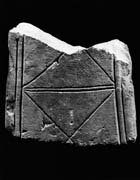Select a site alphabetically from the choices shown in the box below. Alternatively, browse sculptural examples using the Forward/Back buttons.
Chapters for this volume, along with copies of original in-text images, are available here.
Object type: Fragment of stele [1]
Measurements: H. 14 cm (5.5 in); W. 15.2 cm (6 in); D. 10.8 cm (4.25 in)
Stone type: See no. 1
Plate numbers in printed volume: 44-47
Corpus volume reference: Vol 3 p. 60
(There may be more views or larger images available for this item. Click on the thumbnail image to view.)
There is a faint pink flush to the smooth surface of the stone, and dark material in the incised lines may be pigment.
A (broad): The double edge moulding is neatly modelled. Half way up, a double horizontal band is incised. From the corners intersecting diagonals form a saltire in each panel.
B and D (narrow): The double edge moulding surviving on the left-hand side of face B and the right-hand side of face D is identical with that on face A.
C (broad): Broken away.
There are no close parallels for this kind of monument in the British Isles. The fine state of preservation of the surface suggests that its original location may have been inside a building, perhaps marking a grave in a porticus. The group (nos. 11 to 19) is confined to the Minster and seems to have developed into the incised grave-marker reminiscent of the Hartlepool, co. Durham, sequence, at least in terms of surface ornament. There is never any hint of a cross-head to the shaft, so they are obelisk-like monuments with a truncated top. No. 15 preserves a substantial length of the top of such a stele, confirming the absence of cross-head (Ill. 64). How they were arranged in relation to the grave is uncertain. The ornament is extremely restrained, so much so that art-historical judgements are rendered impossible. The more ambitious designs of pieces like no. 19 are a development and the decoration of no. 11 is probably representative of the earliest phase, suggesting a date rather earlier than the reflex to the Hartlepool, co. Durham, type. The same kind of ascetic restraint, along with inscriptions, is found in some of the sculpture from the monastery at Whitby, North Riding: for example, cross no. 3 (Peers and Radford 1943, 36, pl. XXIXa). (See Chap. 5).
1. All the pieces from the Minster were discovered as a result of the excavations of 1966-71 by H. Ramm and D. Phillips. They are to be published as a handlist, together with a critical essay, in the forthcoming Royal Commission volume on the excavations. That publication will provide the finer detail of their archaeological contexts, both in a table, and in a description of the excavation of the south transept cemetery.
The following are general references to the stones: Wilson 1978, 142; Hall 1980b, 7, 21; Lang 1988b, 8, 12; Lang 1989, 5.



